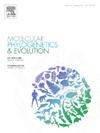Phylogenomic insights into incomplete lineage sorting and hybridization in early-diverging eudicots
IF 3.6
1区 生物学
Q2 BIOCHEMISTRY & MOLECULAR BIOLOGY
引用次数: 0
Abstract
The rise of angiosperms has been regarded as a trigger for the Cretaceous Terrestrial Revolution (KTR). The well-defined clade of eudicots contains 75% of all angiosperm species. However, the order- and family-level relationships among early-diverging eudicot lineages (i.e., Ranunculales, Proteales, Trochodendrales, and Buxales), including the sister group relationship of core eudicots and the positions of Sabiaceae and Eupteleaceae remain controversial. Here, we present phylogenetic analyses of early-diverging eudicots (16 species from 16 genera representing all 13 families) based on nuclear and plastid genomic data. We reconstructed the phylogenetic relationships within early-diverging eudicots using concatenated and coalescent approaches. We performed divergence time estimation, gene tree discordance analysis, incomplete lineage sorting assessment, and phylogenetic network inference. Our results show that nuclear and plastid genomic data generated congruent topologies, but different methods recovered different lineage as sister to core eudicots. The species trees support the Trochodendrales-Buxales clade as sister to core eudicots, while the concatenated trees support Trochodendrales and Buxales as successive sisters to core eudicots. Within eudicots, Ranunculales is the earliest-diverging lineage, followed by Proteales. Eupteleaceae is the earliest-diverging lineage in Ranunculales, followed by Papaveraceae. Sabiaceae is sister to the remaining Proteales. Widespread discordance across nuclear gene trees was observed. We detected substantial incomplete lineage sortings across early-diverging eudicots and identified four potential hybridizations involving Ranunculales, Proteales, and core eudicots. The incomplete lineage sorting is likely the primary source of phylogenetic conflicts among early-diverging eudicots, although hybridization cannot be omitted. The eudicots became differentiated in the Lower Cretaceous and all thirteen families of early-diverging eudicots might have emerged by the Lower-Mid Cretaceous, temporally in agreement with the KTR. Incomplete lineage sorting and hybridization occurred during the early rapid diversification of eudicots might be associated with past environmental changes. These findings shed light on the evolutionary history of early-diverging eudicots, and highlight the roles of incomplete lineage sorting and hybridization in the rapid expansion of angiosperms during the KTR.

早期分化株不完全谱系分类和杂交的系统基因组研究
被子植物的兴起被认为是白垩纪陆地革命(KTR)的导火索。定义明确的菊科分支包含所有被子植物种类的75%。然而,早期分化的龙舌兰科谱系(即毛茛科、Proteales、Trochodendrales和Buxales)的目级和科级关系,包括核心龙舌兰科的姐妹类群关系以及Sabiaceae和Eupteleaceae的位置仍然存在争议。在此,我们基于核和质体基因组数据,对早期分化的异种植物(13科16属16种)进行了系统发育分析。我们用串联和聚结的方法重建了早期分化的埃迪科的系统发育关系。我们进行了发散时间估计、基因树不一致性分析、不完全谱系分类评估和系统发育网络推断。我们的研究结果表明,核和质体基因组数据产生了一致的拓扑结构,但不同的方法恢复了作为核心染色体姐妹的不同谱系。种树支持trochodendrale -Buxales分支作为核心植物的姐妹,而连接树支持trochodendrale和Buxales作为核心植物的连续姐妹。在菊科中,毛茛门是最早分化的分支,其次是毛茛门。毛茛科是毛茛科中分化最早的分支,其次是罂粟科。Sabiaceae是剩余的proteale的姐妹。在核基因树中观察到广泛的不一致。我们在早期分化的eudicos中发现了大量不完整的谱系分选,并确定了四种潜在的杂交,涉及毛茛、Proteales和核心eudicos。尽管不能忽略杂交,但不完整的谱系分类可能是早期分化的ediicots之间系统发育冲突的主要来源。下白垩世渐长岩开始分化,早分化的13科渐长岩可能在中下白垩世出现,时间上与KTR一致。在早期快速多样化过程中发生的谱系分选和杂交不完全可能与过去的环境变化有关。这些发现揭示了早期分化株的进化史,并强调了KTR期间不完全谱系分选和杂交在被子植物快速扩张中的作用。
本文章由计算机程序翻译,如有差异,请以英文原文为准。
求助全文
约1分钟内获得全文
求助全文
来源期刊
CiteScore
7.50
自引率
7.30%
发文量
249
审稿时长
7.5 months
期刊介绍:
Molecular Phylogenetics and Evolution is dedicated to bringing Darwin''s dream within grasp - to "have fairly true genealogical trees of each great kingdom of Nature." The journal provides a forum for molecular studies that advance our understanding of phylogeny and evolution, further the development of phylogenetically more accurate taxonomic classifications, and ultimately bring a unified classification for all the ramifying lines of life. Phylogeographic studies will be considered for publication if they offer EXCEPTIONAL theoretical or empirical advances.

 求助内容:
求助内容: 应助结果提醒方式:
应助结果提醒方式:


